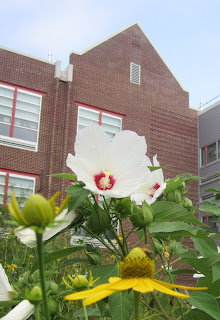Grassy strips between parking areas--shown here in Westminster's current lot--are typically higher than the pavement, forcing runoff immediately into stormdrains.
No longer visible (this photo was taken May 30) is the matrix of 3 foot diameter pipes underneath the pavement that will serve as a giant cistern, holding storm runoff in order to reduce the parking lot's contribution to flash floods downstream in Harry's Brook.
Water from elsewhere in the lot will flow down this drain into a small retention basin at the edge of the Westminster property. The goal of all of this holding capacity, both under and above ground, is to have runoff leave the property more slowly than before the parking lot was built. This approach of slowing the water down gained momentum in 2000, when Maryland published a design manual with the goal of reducing pollution in the Chesapeake Bay.
One way to beautify these swales and basins is with native wildflowers, as we've done at Princeton High School, just across Walnut Lane from Westminster. The high school's "ecolab" wetland--essentially a retention basin converted from grass to native floodplain wildflowers--takes runoff from the school's roof and also the parking lot next to the performing arts center, and is in full bloom right now.






No comments:
Post a Comment